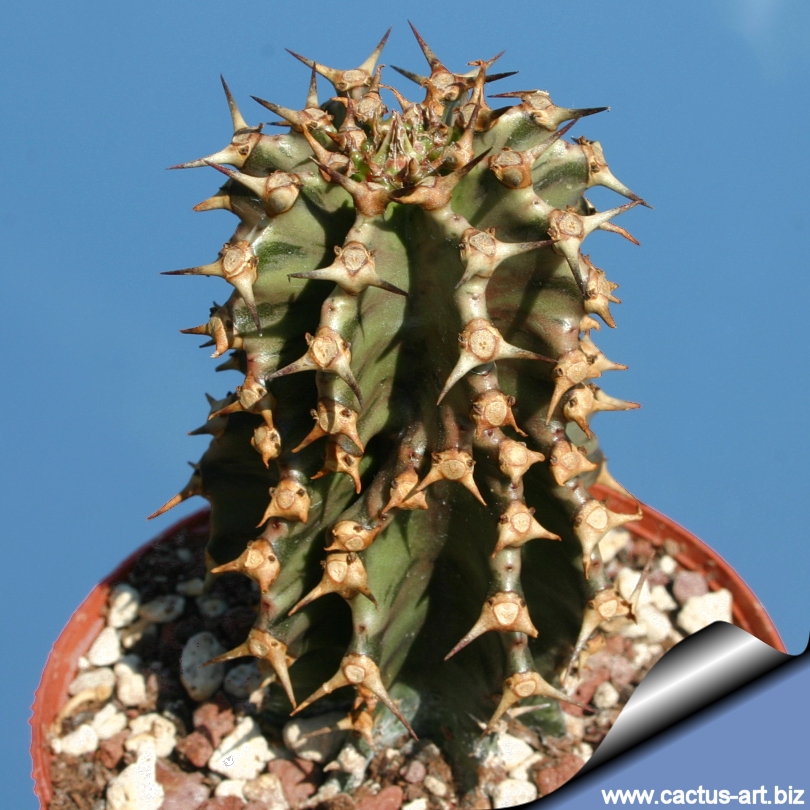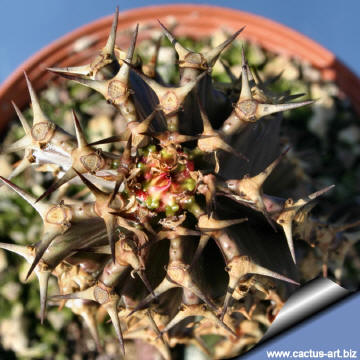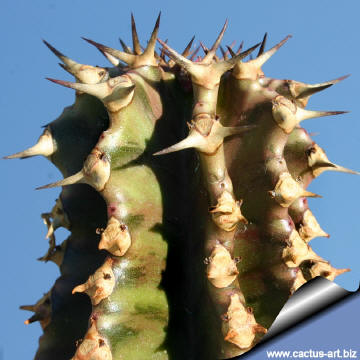|
|
|

Euphorbia
abyssinica
This is a very showy
candlestick tree-like plant which grows arms over time. Stems
edges are ridged with short, pairs of closely packed (almost touching)
triangular, corky, spines up to 7 mm wide and 10 mm long .
|
|
Description: This is a nice
large, cactus-like, candlestick, tree Euphorbia with short thorns. It
form a dense crown of ascending branches usually up to 4,5 m tall (but
reported to reach 9 m of height ) This is a highly variable species with
several forms and making precise descriptions may be difficult.
Stems: Columnar, angular branches, constricted into ovate segment
appox 15 cm long,
Ribs: 8 (4 for E. acruensis) very deep, vertical or
slightly twisted with thin walls and shallow sinuate teeth 12 mm apart.
Stipular spines: In pairs closely packed (almost touching) on the
rib border, triangular up to 7 mm wide and 10 mm long, separate,
becoming corky.
Flowers: 1-5 cyathia up to 12 mm wide born together on simple
cymes, peduncles up to 5 mm long stout, nectar glands elliptic yellow,
almost touching.
Fruits: About 12 x15 mm wide, subglobose, fleshy, white turning
red, hardening, becoming deeply lobed at maturity.
Seeds: Smooth, subglobose, 4,5 x 3,5 mm wide,
NOTE: It has a very clean and neat appearance and is often
confused with with
E.
ammak, E. ingens and E. erythraea .
Nevertheless this plant is often leafed out, especially if warm and
given plenty of water. This makes it easy to tell from , which rarely
has leaves, or they are so small and insignificant. Furthermore E.
abyssinica grows more vertical in form than its cousins.
|
 |
 |
|
Warning: All Euphorbias contain a white sap
that can be irritating to eyes and mucous membranes. If contact is made
with this white sap, take care to not touch face or eyes before washing
hands with soap and water.
Advertising
|
|
|
|
|
|
|
Family: Euphorbiaceae
Accepted
scientific name: Euphorbia
abyssinica J.F.Gmel.
In: Syst. Nat.: 759 1791
Common English Names include:
Candelabra
Spurge.
Origin: It is the the principal tree euphorbia of northeast
Africa ranging from East Sudan (Red Sea Hills) to Eritrea, Northern
Ethiopia and Northern Somalia.
Habitat: Grows in the most exposed places
in well-drained stony soils and in the crevices of rock faces of hills
and slopes, in montane dry deciduous and evergreen woodland and bushland
, woodland and shrub savanna at 850 to 2200 m altitude. It occurs widely
throughout dryland Africa and it is often dominant.
Conservation status: Listed in
CITES appendix 2.
Synonyms:
- Euphorbia abyssinica var. erythraeae
A Berger
- Euphorbia abyssinica var. tetragona
Schweinfurth 1899
- Euphorbia acrurensis N.E.Br. 1912
- Euphorbia aethiopum Croizat 1941
- Euphorbia candelabrum var. erythraeae
A. Berger 1907
- Euphorbia controversa N.E.Br.
1912
- Euphorbia disclusa N.E.Br. 1912
- Euphorbia erythraeae (Berger)
N.E.Br. 1912
- Euphorbia grandis Lemaire 1857
- Euphorbia hararensis Pax 1907
- Euphorbia neglecta N.E.Br. 1912
- Euphorbia neutra A.Berger 1907
- Euphorbia obovalifolia A.Richard
1851
- Euphorbia officinarum var. kolquall
Willddenow 1799
- Euphorbia richardiana Baillon
1860
|
|
|
|
Cultivation: It is an easy species to grow that is suited for any
well drained soil in full sun. But young plant are happy growing
indoors, where they can easily reach the ceiling. Give the plant an airy
growing medium which mainly consists of non organic material such us
clay, pumice, lava grit, and only a little peat or leaf-mould. Water
regularly during the active growing season from March to September. No
water should ever be allowed to stand around the roots. Keep almost
completely dry in winter. It is a moderately fast grower, and will
quickly become large landscape masterpieces in just 3-5 years. Only
downside is from strong winds, the columns often smash into each other,
causing permanent scarring... best to plant in such a location where
winds are not a big issue. If plant becomes very red, this is a sign
that the roots have not developed properly. It can tolerate
moderate shade, and a plant that has been growing in shade should be
slowly hardened off before placing it in full sun as the plant will be
severely scorched if moved too suddenly from shade into sun. Like quite
small pots, repott in very later winter, early spring. Can be pruned for
shape and branching. Frost tender, frost free zones only. It is
definitely more tender than
E.
ammak or E. ingens, and slower growing, it
will be content in its position and with its soil for years.
Propagation: It is
easy to propagate by cuttings in late spring to summer, just take
a cutting of the plant let it dry for 1 or 2 weeks and stuff it in the
ground (preferably dry, loose, extremely well draining soil).
Uses:
- Gardening: This tree can be grown in large, rocky, well-drained
soil in gardens in drier areas. It is very drought
resistant but susceptible to frost. It makes one of the better house
plants for an Euphorbia, dealing well with low light situations
(though recommend higher light if possible). Somewhat user-friendly
with only sparse spines along the edges of the plant. Slightly
delicate, though, and spines tear off easily, exposing that latexy
sap. It is also appreciated as a live fence because it is easily
propagated from untreated mature branch cuttings.
- Fuel production: The Italians attempted
to grow Euphorbia abyssinica in 1935-36 to use its latex to produce a
gasoline-like substitute.
-
Fishing: It is used to stupefy fish, making it possible to catch
them by hand. The fish poison is prepared by soaking a bundle of grass
in the latex, tying it to a stone and throwing it into the water.
Paralysed fish rise to the surface within a short period of time.


|
|